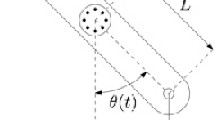Abstract
The paper examines a singular perturbation model of tracking two targets, one slow and a fast one which is assumed periodic. The plant is linear and the cost is quadratic. A limit problem is displayed. It corresponds to the limit behavior of the perturbed system when the small parameter tends to zero. This limit is not of reduced order, as the fast target is periodic. Rather, an infinite-horizon optimal averaging is performed on the fast scale, and serves as an input to slow-scale optimization. This limit design is used to approximate the optimal solution of the singularly perturbed system. Bounds for the rates of the approximation are given. The optimal limit design is computed in a feedback form in the general case, and for illustrative concrete examples.
Similar content being viewed by others
References
Z. Artstein, Chattering variational limits of control systems.Forum Math. 5 (1993), 369–403.
Z. Artstein and V. Gaitsgory, Tracking fast trajectories along a slow dynamics: A singular perturbation approach.SIAM J. Control Optim., to appear.
Z. Artstein and A. Leizarowitz, Tracking periodic signals with the overtaking criterion.IEEE Trans. Automat. Control 30 (1985), 1123–1126.
Z. Artstein and A. Vigodner, Singularly perturbed ordinary differential equations with dynamic limits.Proc. Roy. Soc. Edinburgh Sect. A 126 (1996), 541–569.
M. Athans and P. L. Falb,Optimal Control. McGraw-Hill, New York, 1966.
R. W. Brockett,Finite Dimensional Linear Systems. Wiley, New York, 1970.
D. A. Carlson, A. B. Haurie, and A. Leizarowitz,Infinite Horizon Optimal Control. Springer-Verlag, Berlin, 1987.
J. H. Chow and P. V. Kokotovic, A decomposition of near-optimum regulators for systems with slow and fast modes.IEEE Trans. Automat. Control 21 (1976), 701–705; reprinted in [KK].
A. L. Donchev,Perturbations, Approximations and Sensitivity Analysis of Optimal Control Systems. Lecture Notes in Control and Information Science, vol. 52, Springer-Verlag, Berlin, 1983.
W. H. Fleming and H. M. Soner,Controlled Markov Processes and Viscosity Solutions. Springer-Verlag, New York, 1993.
V. Gaitsgory, Suboptimization of singularly perturbed control systems.SIAM J. Control Optim. 30 (1992), 1228–1249.
V. Gaitsgory, Suboptimal control of singularly perturbed systems and periodic optimization.IEEE Trans. Automat. Control 38 (1993), 888–903.
A. H. Haddad and P. V. Kokotovic, Note on singular perturbation of linear state regulator.IEEE Trans. Automat. Control 16 (1971), 279–281; reprinted in [KK].
R. E. Kalman, Contributions to the theory of optimal control.Bol. Soc. Mat. Mexicana 5 (1960), 102–119.
P. V. Kokotovic and H. K. Khalil,Singular Perturbations in Systems and Control. IEEE Selected Reprint Series, IEEE Press, New York, 1986.
P. V. Kokotovic, H. K. Khalil, and J. O'Reilly,Singular Perturbations in Control Analysis and Design. Academic Press, New York, 1986.
P. V. Kokotovic and R. A. Yackel, Singular perturbations of linear regulators: basic theorems.IEEE Trans. Automat. Control 17 (1972), 29–37; reprinted in [KK].
P. Lancaster and M. Tismenetsky,The Theory of Matrices, 2nd edition. Academic Press, Orlando, FL, 1985.
R. E. O'Malley, Jr., The singularly perturbed linear state regulator problem.SIAM J. Control 10 (1972), 399–413; reprinted in [KK].
R. E. O'Malley, Jr., Singular perturbation of the time invariant linear state regulator problem.J. Differential Equations 12 (1972), 117–128.
R. E. O'Malley, Jr., On two methods of solution for a singularly perturbed linear state regulator problem.SIAM Rev. 17 (1975), 16–37.
R. E. O'Malley, Jr., and C. F. Kung, On the matrix Riccati approach to a singularly perturbed regulator problem.J. Differential Equations 16 (1974), 413–427.
R. E. O'Malley, Jr., and C. F. Kung, The singularly perturbed linear state regulator problem, II.SIAM J. Control 13 (1975), 327–337.
P. Sannuti and P. V. Kokotovic, Near-optimum design of linear systems by a singular perturbation method.IEEE Trans. Automat. Control 14 (1969), 15–22.
V. M. Volosov, Averaging in systems of ordinary differential equations.Russian Math. Surveys 17(6) (1962), 1–126.
Author information
Authors and Affiliations
Additional information
Zvi Artstein is an incumbent of the Hettie H. Heineman Professorial Chair in Mathematics. The work by Vladimir Gaitsgory was done while visiting the Department of Theoretical Mathematics, The Weizmann Institute of Science, Rehovot, Israel.
Rights and permissions
About this article
Cite this article
Artstein, Z., Gaitsgory, V. Linear-quadratic tracking of coupled slow and fast targets. Math. Control Signal Systems 10, 1–30 (1997). https://doi.org/10.1007/BF01219773
Received:
Revised:
Issue Date:
DOI: https://doi.org/10.1007/BF01219773



